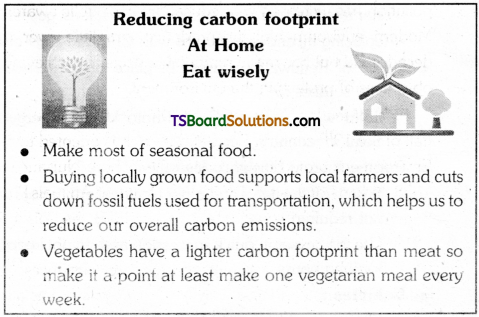Telangana TSBIE TS Inter 1st Year Environmental Education Study Material 19th Lesson What is Sustainable Development Textbook Questions and Answers.
TS Inter 1st Year Environmental Education Study Material 19th Lesson What is Sustainable Development
Essay Questions
Question 1.
Write an essay an Sustainable Development.
Answer:
Today there is serious concern about the earth’s growing fragility. As global citizens, we must realize that our actions have consequences for the entire world. Economic development cannot be viewed in isolation from social and ecological development. We have to ensure that the path of development that we follow is all-inclusive and in harmony with the environment of the earth. This is possible only if there is co-operation amongst all the people of the world. The ancient sages, in their wisdom, summed up this concept aptly – ‘Vasudhaiva Kutum- bakam’ (The world is a family).
What is Sustainable Development?
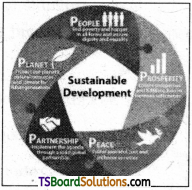
In 1987, the Brundtland Commission published a report, Our Common Future, in an effort to link the issues of economic development and environmental stability. In doing so, this report provided the oft-cited definition of sustainable development as “development that present without compromising the ability of future generations to meet their own needs”. The concept of sustainable development aims to maintain economic advancement and progress while protecting the longterm value of the environment.
- Sustainable development calls for concerted efforts towards building an inclusive, sustainable and resilient future for the people and the planet.
- For sustainable development to be achieved, it is crucial to harmonize three core elements : economic growth, social inclusion and environmental protection. These elements are interconnected and all are crucial for the wellbeing of individuals and societies.
- Eradicating poverty in all its forms and dimensions is an indispensable requirement for sustainable development. To this end, there must be promotion of sustainable, inclusive and equitable economic growth, creating greater opportunities for all, reducing inequalities, raising basic standards of living, fostering equitable social development and inclusion, and promoting integrated and sustainable management of natural resources and ecosystems. The diagram at the side illustrates the interaction between the ecology, economy and social (community) development.
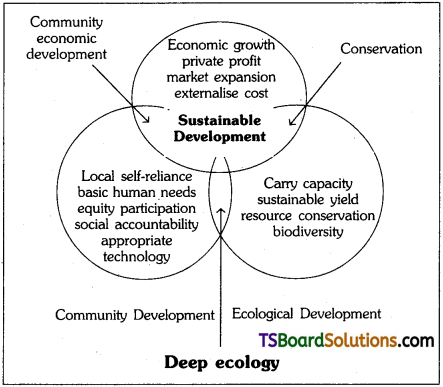
Threats to ‘Sustainable Development’:
Economic disparity, social inequality and environmental degradation are threats to sustainability. Some of the causes of unsustainability are as follows :
- increasing human population;
- over-exploitation of resources to meet human needs like fuel, fodder and shelter;
- activities like fishing, agriculture, over use of fresh water, deforestation and industrialization;
- land clearing – it leads to problems like soil degradation, pollution, loss of biodiversity, deforestation, desertification, climate change;
- social degradation due to factors like increasing unemployment, health crisis, armed conflict, urbanization, poverty, income inequity.
The world as a whole is steadfast in its commitment towards achieving a balance between environmental, economic and social development. The agenda of ‘Sustainable Development’ is also an all-inclusive growth. It is a pattern of development that involves all sections of the community – the well off, the poor, men and women.
How can Sustainable Development be implemented?
Sustainable Development is possible if we undertake the following strategies :
- Preservation of biological diversity in terrestrial, fresh water and marine systems;
- Sustainable use of resources and minimising the depletion of resources;
- Caring for the environment;
- Improving the quality of life including social and economic concerns ;
- Conservation of natural capital both for renewable and non-renewable resources;
- Conservation of natural and cultural diversity;
- Limits on natural resource utilisation and assimilation of wastes;
- Efficiency of resource utilisation by all societies;
- Social equity through poverty reduction and gender equity;
- Reduction of emission of greenhouse gases;
- Reduction in use of ozone depleting substances;
- Reduction in air pollution;
- Reduction in use of chemical fertilizers;
- Stopping desertification; and
- Stopping deforestation.
![]()
Question 2.
Write an essay on sustainable consumption.
Answer:
Sustainable Development aims to ensure sustainable consumption and production patterns. The Sustainable Development Goals (SDGs) are a collection of 17 global goals set by the United Nations in 2015.
Sustainable Consumption :
The concept of sustainable consumption and production was recognized in the Johannesburg Plan of Implementation, adopted in 2002 at the World Summit on Sustainable Development (WSSD). It was acknowledged that fundamental changes in the way societies produce and consume are indispensable for achieving global sustainable development.
The 10 – year frame work of programme (10 YFP) on sustainable consumption and production patterns was adopted at the Rio+20 Conference in 2012.
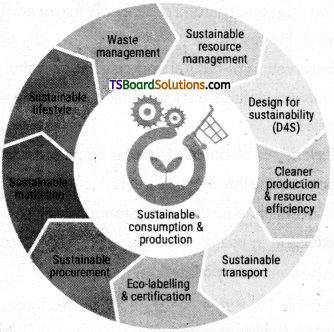
Consumption patterns and expectations are deeply entrenched in most societies and cultures. Industrialized world citizens overall generate three-quarters of other wide ranging pollutants, also toxic chemicals and hazardous wastes. Much the same applies to the depletion of many of the world’s nonrenewable natural resources. Hence, the consumption problem lies primarily with affluent communities, and they bear a responsibility to pioneer a path towards sustainable consumption. This is all the more pertinent in so far as sizable communities in Eastern Europe and the former Soviet Union, as well as in China, India, Southeast Asia, and Latin America, are entering the consumption classes. While poor communities certainly need to increase their consumption, they might consider less wasteful and polluting forms of consumption than those that characterize rich nations.
Sustainable Consumption and Development :
Sustainable Development’ is concerned with the rate of consumption and use of natural resources. The focus is on ensuring that we do not consume the resources at a rate that makes it difficult for us to substitute or replace them. If we use cars then we have to make sure that we use eco-friendly fuel and technology that minimises air pollution. If we use ground water then we also have a responsibility of recharging it through various techniques like rain water harvesting.
‘Sustainable Development’ is thus, responsible development. It is economic development that keeps in mind the needs of the society and environment. It is development that is inclusive development that reaches all sections of society. It is a development that benefits all sections of society and is not at the cost of the earth’s ecology.
Exploitation pressures on natural resources are already unsustainable in several respects apart from global warming. We use over half of available fresh water runoff, an amount projected to rise to three-quarters by 2025 through population growth alone. The number of water-short people today, 550 million, could well soar to 3 billion by 2025. Much the same prospect — reflecting fast-growing consumption in relation to expanding population and environmentally adverse technology — applies to other strategic resource stocks such as topsoil, forests, grasslands, fisheries, biodiversity, climate, and the atmosphere.
![]()
Policy Options :
We can increase resource-use efficiency through fewer materials inputs, longer product lifetimes, and waste prevention. We could accomplish much by utilizing technologies already available. With the right incentives, there could even be a fourfold increase in resource productivity. Efficiency enables sufficiency. In particular, we should make use of the “energy source” that is the cheapest, most widely available, and least exploited, namely, efficiency and conservation.
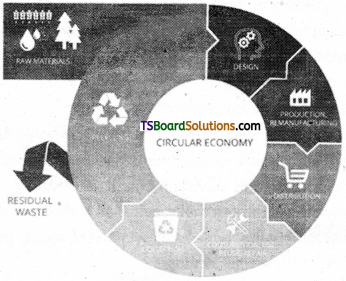
Sustainable consumption and production is about promoting resource and energy efficiency, sustainable infrastructure, and providing access to basic services, green and decent jobs and a better quality of life for all. Its implementation helps to achieve overall development plans, reduce future economic, environmental and social costs, strengthen economic competitiveness and reduce poverty. It involves different stakeholders, including business, consumers, policy makers, researchers, scientists, retailers, media and development co-operation agencies, among others.
It involves engaging consumers through awareness-raising and education on sustainable consumption and lifestyles, providing consumers with adequate information through standards and labels and engaging in sustainable public procurement, among others.
- Each year, an estimated one third of all food produced – equivalent to 1.3 billion tonnes worth around $1 trillion – ends up rotting in the bins of consumers and retailers, or spoiling due to poor transportation and harvesting practices.
- If people worldwide switched to energy efficient light bulbs the world would save US$120 billion annually.
- Should the global populate reach 9.6 billion by 2050, the equivalent of almost three planets could be required to provide the natural resources needed to sustain current lifestyles.
Water :
- Less than 3 percent of the world’s water is fresh (drinkable), of which 2.5 percent is frozen in the Antarctica, Arctic and glaciers. Humanity must therefore, rely on 0.5 percent for all of man’s ecosystem’s and fresh water needs.
- Man is polluting water faster than nature can recycle and purify water in rivers and lakes.
- More than 1 billion people still do not have access to fresh water.
- Excessive use of water contributes to the global water stress.
- Water is free from nature but the infrastructure needed to deliver it is expensive.
Energy :
- Despite technological advances that have promoted energy efficiency gains, energy use in Organisation for Economic Co-operation and Development (OECD) countries will continue to grow another 35 percent by 2020. Commercial and residential energy use is the second most rapidly growing area of global energy use after transport.
- In 2002 the motor vehicle stock in OECD countries was 550 million vehicles (7 percent of which were personal cars). A 32 percent increase in vehicle ownership is expected by 2020. At the same time, motor vehicle kilometers are projected to increase by 40 percent and global air travel is projected to triple in the same period.
- Households consume 29 percent of global energy and consequently contribute to 21 percent of resultant CO2 emissions.
- In India the motorised transport is increasing uniformly at a Compounded Annual Growth Rate (CAGR) of 10.5% leading to higher impetus on the oil sector.
- One-fifth of the world’s final energy consumption in 2013 was from renewables.
Food :
- While substantial environmental impacts from food occur in the production phase (agriculture, food processing), house-holds influence these impacts through their dietary choices and habits. This consequently affects the environment through food-related energy consumption and waste generation.
- 1.3 billion tonnes of food is wasted every year while almost 1 billion people go undernourished and another 1 billion hungry.
- Over consumption of food is detrimental to our health and the environment.
- 2 billion people globally are overweight or obese.
- Land degradation, declining soil fertility, unsustainable water use, overfishing and marine environment degradation are all lessening the ability of the natural resource base to supply food.
- The food sector accounts for around 30 percent of the world’s total energy consumption and accounts for around 22 percent of total Greenhouse Gas Emissions.
Low Carbon Life Styles :
The increased emissions of carbon- dioxide over the last few decades have led to an alarming increase in average global temperatures. This phenomenon is called global warming. If this trend continues, the planet is doomed.
At the individual level, we contribute to the emission of carbon dioxide in almost every activity we perform. Some activities lead to large emissions of carbon, while others do not. Going by plane from Hyderabad to Chennai, for instance, causes much more emission of carbon dioxide than travelling the same distance by bus. Eating a dosa at home causes less emission of carbon dioxide than eating a pizza in a restaurant or even eating the same kind of dosa there. Running an air conditioner causes more carbon dioxide emissions than running a fan.
Every citizen has the responsibility of initiating measures to reduce the impact of his activities on the environment. He should strive to have a ’low carbon footprint’ by reducing his carbon dioxide emissions. A low carbon life saves energy and reduces greenhouse gases.
![]()
How to adopt a low carbon life style :
At Home :
- Switch to Energy efficient devices; these can be identified by the rating available on the electrical applicances.
- 5 star rated refrigerators, air conditioners, fans, geysers etc.
- Replacing incandescent bulbs with CFL and LED ones.
Usage of Renewable sources in place of rion-renewable energy sources :
- Solar water heaters, Solar Photo Voltaic energy, and Solar inverters.
Practise Energy Efficiency Measures :
- Switch off the lights and other electrical appliances when not required.
- Use the geyser in quick succession and do not keep it on for long hours.
Vehicles :
- Minimise vehicle usage by walking or cycling.
- Inflate tyres regularly for increased mileage.
- Regular maintenance of the vehicle gives energy efficiency.
- Carpooling and planning your trips will reduce fuel consumption.
In the Kitchen :
- Use fresh, seasonal, locally produced, organic foods.
- Avoid red meat like beef and lamb.
- Cut down on eating at restaurants.
- Reduce food waste
- Use a pressure cooker to cook food
- Soak rice and other ingredients like pulses at least half an hour before cooking.
Water Consumption :
- Harvest Rain Water
- Conserve water by using improved taps and faucets
- The capacity of flush tanks may be reduced and two-stage flush tanks may be used.
